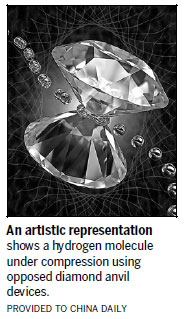
China hires top physicist to continue quest featured on the cover of Nature.
In the popular Harry Potter series, the most advanced dark magic, "petrification", is the process of turning people into stone.
In China, turning hydrogen, a gas, into a superconducting metal is a new kind of magical pursuit with tantalizing possibilities, and a recent breakthrough in physics at the University of Edinburgh's School of Physics and Astronomy in the United Kingdom is pointing the way. Scientists there confirmed for the first time that hydrogen under extreme pressure takes on early characteristics of a metal - a state they call Phase V.
The discovery, which was featured on the cover of the prestigious scientific journal Nature in January, could lead to superconductivity at normal temperatures and revolutionize the world's energy picture.
And now the technology is coming to China, along with one of the world's leading hydrogen researchers, Eugene Gregoryanz, a Canadian who co-authored the Nature article.
A physics professor at Edinburgh, Gregoryanz was invited to China under the government's Thousand Talents program, which recruits top foreign experts.
Metallic hydrogen was predicted 80 years ago, but had never been observed. Because of its implications for superconductivity - and hydrogen's importance in fundamental science - the metallic phase has become the "Holy Grail" of high-pressure physics, Gregoryanz said.
"For nonscientists, what we did probably appears as some dark magic. But it is all based on the laws of physics," he said.
Gregoryanz has been working since 2014 with the Institute for Solid State Physics, affiliated with the Chinese Academy of Sciences, and based in Hefei, Anhui province. He is building high-pressure devices in China like the equipment he used in Britain. It will be the first such equipment in the country.
"There was good equipment here to start with," Gregoryanz said. "Some was even better than at the University of Edinburgh. For example, in Edinburgh, there are no low-temperature facilities. But here the equipment is very good."
Previously, only five or six groups in the world, including Gregoryanz's at Edinburgh, have been able to make a high-pressure hydrogen sandwich - loading hydrogen into a "diamond anvil cell" consisting of two opposing diamonds that are pushed together by a special mechanism, with hydrogen in between. Such equipment was used in the recent experimental success reported by Nature.
But only three of the groups were able to compress hydrogen above 2 million Earth atmospheres of pressure, Gregoryanz said.
"Our group in Hefei will be the next one capable of taking hydrogen to the pressures found at the center of the Earth and above," he said.
 Gregoryanz's team used two diamonds to crush hydrogen samples with pressures as high as 380 GigaPascals - equivalent to 3.8 million times Earth's atmosphere. The hydrogen molecules started to break down, separating into individual atoms, and began to show metallic features in optical measurements.
Gregoryanz's team used two diamonds to crush hydrogen samples with pressures as high as 380 GigaPascals - equivalent to 3.8 million times Earth's atmosphere. The hydrogen molecules started to break down, separating into individual atoms, and began to show metallic features in optical measurements.
"Even though metallization of elements and compounds under pressure is not new, metallization of hydrogen, specifically, has been the Holy Grail of high-pressure physics for the past 40 years, mostly because metallic hydrogen is predicted to have very strange and fascinating properties unlike any other material," Gregoryanz said.
With just a little higher pressure, the hydrogen could reach a fully metallic state, which is predicted to be superconductive at room temperature, he said.
Superconducting materials transmit electricity without resistance under certain circumstances, usually at temperatures below-200 C.
"If we can manage to make metallic hydrogen with superconductivity at room temperature - a temperature feasible for industrial use - we can apply it to power transmission networks with zero power loss," said Liu Xiaodi of the solid state physics institute of the CAS.
Gregoryanz said he is currently working with several Chinese scientists on projects involving hydrogen at high pressures and low temperatures.
"We soon hope to publish several papers that will be 100 percent work from China," he said. (China Daily)

86-10-68597521 (day)
86-10-68597289 (night)

52 Sanlihe Rd., Xicheng District,
Beijing, China (100864)

